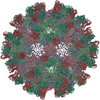+ データを開く
データを開く
- 基本情報
基本情報
| 登録情報 | データベース: PDB / ID: 8w5n | |||||||||||||||||||||
|---|---|---|---|---|---|---|---|---|---|---|---|---|---|---|---|---|---|---|---|---|---|---|
| タイトル | Cryo-EM structure of Qb-Ab21 | |||||||||||||||||||||
 要素 要素 |
| |||||||||||||||||||||
 キーワード キーワード | IMMUNE SYSTEM / Qb / Antibody / cryo-EM | |||||||||||||||||||||
| 機能・相同性 | Read-through domain / Read-through domain / Levivirus coat protein / Levivirus coat protein / Bacteriophage RNA-type, capsid / viral capsid / structural molecule activity / Minor capsid protein A1 機能・相同性情報 機能・相同性情報 | |||||||||||||||||||||
| 生物種 |  Escherichia phage Qbeta (ファージ) Escherichia phage Qbeta (ファージ) | |||||||||||||||||||||
| 手法 | 電子顕微鏡法 / 単粒子再構成法 / クライオ電子顕微鏡法 / 解像度: 3.1 Å | |||||||||||||||||||||
 データ登録者 データ登録者 | Bao, K.Y. / Li, R.H. / Hua, Z.L. / Hou, B.D. / Zhu, P. | |||||||||||||||||||||
| 資金援助 |  中国, 4件 中国, 4件
| |||||||||||||||||||||
 引用 引用 |  ジャーナル: Cell Rep / 年: 2025 ジャーナル: Cell Rep / 年: 2025タイトル: Competition propels, rather than limits, the success of low-affinity B cells in the germinal center response. 著者: Runhan Li / Keyan Bao / Can Liu / Xuejing Ma / Zhaolin Hua / Ping Zhu / Baidong Hou /  要旨: The germinal center (GC) sets an environment where antigen-specific B cells are compelled to continuously increase their affinity to compete for the antigen and obtain Tfh help for survival and ...The germinal center (GC) sets an environment where antigen-specific B cells are compelled to continuously increase their affinity to compete for the antigen and obtain Tfh help for survival and propagation. Previous studies indicated that low-affinity B cells are disadvantaged in the presence of high-affinity ones, suggesting that competition may lead to the elimination of low-affinity B cells and their descendants. However, using a multivalent virus-mimicking antigen, our study demonstrates that low-affinity B cells not only successfully participate in GC responses alongside high-affinity B cells but also undergo accelerated affinity maturation under the more stringent competition. Furthermore, our cryo-electron-microscopy-based structural analysis reveals that both low-affinity and high-affinity B cells compete for the same antigenic epitope. Although the applicability of this idealized GC competition to true pathogen-induced responses remains uncertain, this change in perspective on the role of competition in low-affinity B cell evolution provides valuable insights for vaccine development. | |||||||||||||||||||||
| 履歴 |
|
- 構造の表示
構造の表示
| 構造ビューア | 分子:  Molmil Molmil Jmol/JSmol Jmol/JSmol |
|---|
- ダウンロードとリンク
ダウンロードとリンク
- ダウンロード
ダウンロード
| PDBx/mmCIF形式 |  8w5n.cif.gz 8w5n.cif.gz | 114.6 KB | 表示 |  PDBx/mmCIF形式 PDBx/mmCIF形式 |
|---|---|---|---|---|
| PDB形式 |  pdb8w5n.ent.gz pdb8w5n.ent.gz | 89.6 KB | 表示 |  PDB形式 PDB形式 |
| PDBx/mmJSON形式 |  8w5n.json.gz 8w5n.json.gz | ツリー表示 |  PDBx/mmJSON形式 PDBx/mmJSON形式 | |
| その他 |  その他のダウンロード その他のダウンロード |
-検証レポート
| 文書・要旨 |  8w5n_validation.pdf.gz 8w5n_validation.pdf.gz | 1.4 MB | 表示 |  wwPDB検証レポート wwPDB検証レポート |
|---|---|---|---|---|
| 文書・詳細版 |  8w5n_full_validation.pdf.gz 8w5n_full_validation.pdf.gz | 1.4 MB | 表示 | |
| XML形式データ |  8w5n_validation.xml.gz 8w5n_validation.xml.gz | 32.2 KB | 表示 | |
| CIF形式データ |  8w5n_validation.cif.gz 8w5n_validation.cif.gz | 45.4 KB | 表示 | |
| アーカイブディレクトリ |  https://data.pdbj.org/pub/pdb/validation_reports/w5/8w5n https://data.pdbj.org/pub/pdb/validation_reports/w5/8w5n ftp://data.pdbj.org/pub/pdb/validation_reports/w5/8w5n ftp://data.pdbj.org/pub/pdb/validation_reports/w5/8w5n | HTTPS FTP |
-関連構造データ
| 関連構造データ |  37298MC  8w5dC  8w5eC  8w5fC  8w5gC  8w5hC  8w5iC  8w5lC  8w5mC  8w5oC  8w5pC  8w5qC  8w5rC  8w5tC  8w5uC  8w5vC  8w5wC M: このデータのモデリングに利用したマップデータ C: 同じ文献を引用 ( |
|---|---|
| 類似構造データ | 類似検索 - 機能・相同性  F&H 検索 F&H 検索 |
- リンク
リンク
- 集合体
集合体
| 登録構造単位 | 
|
|---|---|
| 1 | x 60
|
| 2 |
|
| 3 | x 5
|
| 4 | x 6
|
| 5 | 
|
| 対称性 | 点対称性: (シェーンフリース記号: I (正20面体型対称)) |
- 要素
要素
| #1: タンパク質 | 分子量: 14268.071 Da / 分子数: 3 / 由来タイプ: 組換発現 由来: (組換発現)  Escherichia phage Qbeta (ファージ) Escherichia phage Qbeta (ファージ)発現宿主:  #2: 抗体 | | 分子量: 13729.213 Da / 分子数: 1 / 由来タイプ: 組換発現 / 由来: (組換発現)   Homo sapiens (ヒト) Homo sapiens (ヒト)#3: 抗体 | | 分子量: 12406.779 Da / 分子数: 1 / 由来タイプ: 組換発現 / 由来: (組換発現)   Homo sapiens (ヒト) Homo sapiens (ヒト)Has protein modification | Y | |
|---|
-実験情報
-実験
| 実験 | 手法: 電子顕微鏡法 |
|---|---|
| EM実験 | 試料の集合状態: PARTICLE / 3次元再構成法: 単粒子再構成法 |
- 試料調製
試料調製
| 構成要素 | 名称: Complex of Qb-Ab21 / タイプ: COMPLEX / Entity ID: all / 由来: RECOMBINANT |
|---|---|
| 由来(天然) | 生物種:  |
| 由来(組換発現) | 生物種:  Homo sapiens (ヒト) Homo sapiens (ヒト) |
| 緩衝液 | pH: 7.4 |
| 試料 | 包埋: NO / シャドウイング: NO / 染色: NO / 凍結: YES |
| 急速凍結 | 凍結剤: ETHANE |
- 電子顕微鏡撮影
電子顕微鏡撮影
| 実験機器 |  モデル: Talos Arctica / 画像提供: FEI Company |
|---|---|
| 顕微鏡 | モデル: FEI TECNAI ARCTICA |
| 電子銃 | 電子線源:  FIELD EMISSION GUN / 加速電圧: 200 kV / 照射モード: FLOOD BEAM FIELD EMISSION GUN / 加速電圧: 200 kV / 照射モード: FLOOD BEAM |
| 電子レンズ | モード: BRIGHT FIELD / 最大 デフォーカス(公称値): 1600 nm / 最小 デフォーカス(公称値): 1200 nm |
| 撮影 | 電子線照射量: 50 e/Å2 フィルム・検出器のモデル: GATAN K2 SUMMIT (4k x 4k) |
- 解析
解析
| EMソフトウェア | 名称: PHENIX / バージョン: 1.13_2998: / カテゴリ: モデル精密化 |
|---|---|
| CTF補正 | タイプ: PHASE FLIPPING AND AMPLITUDE CORRECTION |
| 3次元再構成 | 解像度: 3.1 Å / 解像度の算出法: FSC 0.143 CUT-OFF / 粒子像の数: 12102 / 対称性のタイプ: POINT |
 ムービー
ムービー コントローラー
コントローラー



















 PDBj
PDBj

